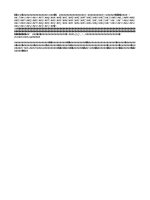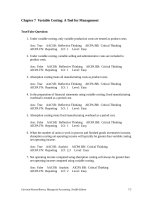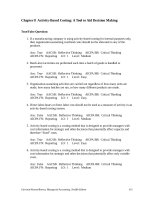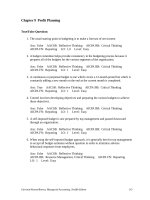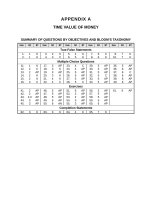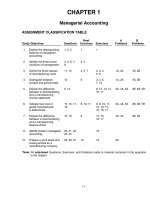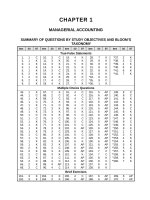Test bank managerial accounting by kieso weygandt 5e ch001
Bạn đang xem bản rút gọn của tài liệu. Xem và tải ngay bản đầy đủ của tài liệu tại đây (123.51 KB, 26 trang )
CHAPTER 1
Managerial Accounting
ASSIGNMENT CLASSIFICATION TABLE
Study Objectives
Questions
Brief
Exercises
Exercises
A
Problems
B
Problems
*1.
Explain the distinguishing
features of managerial
accounting.
1, 2, 3
1
1
*2.
Identify the three broad
functions of management.
4, 5, 6, 7,
8
2, 3
*3.
Define the three classes
of manufacturing costs.
11, 12
4, 5, 7
2, 3, 4,
5, 6
1A, 2A
1B, 2B
*4.
Distinguish between
product and period costs.
13
6
3, 4, 5,
7, 13
1A, 2A
1B, 2B
*5.
Explain the difference
between a merchandising
and a manufacturing
income statement.
9, 14
8, 12, 13, 14,
15, 17
3A, 4A, 5A
3B, 4B, 5B
*6.
Indicate how cost of
goods manufactured
is determined.
15, 16, 17,
18
8, 10, 11
8, 9, 10, 11,
12, 13, 14,
15, 16, 17
3A, 4A, 5A
3B, 4B, 5B
*7.
Explain the difference
between a merchandising
and a manufacturing
balance sheet.
10, 19
9
14, 15,
16, 17
3A, 4A
3B, 4B
*8.
Identify trends in managerial
accounting.
20, 21, 22
23, 24
*9.
Prepare a work sheet and
closing entries for a
manufacturing company.
25, 26, 27
18
12
19
6A
*Note: All asterisked Questions, Exercises, and Problems relate to material contained in the appendix
to the chapter.
1-1
ASSIGNMENT CHARACTERISTICS TABLE
Problem
Number
Description
Difficulty
Level
Time
Allotted (min.)
1A
Classify manufacturing costs into different categories and
compute the unit cost.
Simple
20–30
2A
Classify manufacturing costs into different categories and
compute the unit cost.
Simple
20–30
3A
Indicate the missing amount of different cost items, and
prepare a condensed cost of goods manufactured schedule,
an income statement, and a partial balance sheet.
Moderate
30–40
4A
Prepare a cost of goods manufactured schedule, a partial
income statement, and a partial balance sheet.
Moderate
30–40
5A
Prepare a cost of goods manufactured schedule and a
correct income statement.
Moderate
30–40
1B
Classify manufacturing costs into different categories and
compute the unit cost.
Simple
20–30
2B
Classify manufacturing costs into different categories and
compute the unit cost.
Simple
20–30
3B
Indicate the missing amount of different cost items, and
prepare a condensed cost of goods manufactured schedule,
an income statement, and a partial balance sheet.
Moderate
30–40
4B
Prepare a cost of goods manufactured schedule, a partial
income statement, and a partial balance sheet.
Moderate
30–40
5B
Prepare a cost of goods manufactured schedule and a
correct income statement.
Moderate
30–40
*6A
Complete a worksheet; prepare a cost of goods
manufactured schedule; an income statement, and a
balance sheet; journalize and post the closing entries.
Complex
40–50
1-2
1-3
Broadening Your Perspective
*9. Prepare a work sheet and closing
entries for a manufacturing
company
Q1-26
Q1-23
Q1-24
E1-18
E1-19
P1-6A
BE1-9
E1-14
E1-16
Q1-15
Q1-16
Q1-17
Q1-18
BE1-8
BE1-10
E1-8
E1-12
E1-13
E1-4
E1-5
E1-7
BE1-7 E1-4
E1-2
E1-5
E1-3
E1-6
Q1-8
BE1-2
BE1-3
Real-World Focus
Q1-25
Q1-27
BE1-12
Q1-20
Q1-21
Q1-22
* 8. Identify trends in managerial
accounting.
E1-15
* 6. Indicate how cost of goods
manufactured is determined.
Q1-10
E1-15
Q1-9
Q1-14
E1-15
* 5. Explain the difference between a
merchandising and a manufacturing
income statement.
* 7. Explain the difference between a
Q1-19
merchandising and a manufacturing
balance sheet.
Q1-13
BE1-6
E1-3
* 4. Distinguish between product
and period costs.
Q1-12
BE1-4
BE1-5
* 3. Define the three classes
of manufacturing costs.
Q1-11
Q1-4
Q1-5
Q1-6
Q1-7
* 2. Identify the three broad functions
of management.
BE1-1
E1-1
Comprehension
Q1-1
Q1-2
Q1-3
Knowledge
* 1. Explain the distinguishing features
of managerial accounting.
Study Objective
BE1-11
E1-8
E1-9
E1-10
E1-11
E1-12
E1-14
E1-17
P1-4A
E1-13
P1-1A
P1-2A
P1-1A
P1-2A
P1-1B
Application
P1-5B
E1-8
E1-10
E1-11
P1-3A
P1-5A
P1-3B
Decision Making
Across the
Organization
Communication
Managerial Analysis
Exploring the Web
E1-17 P1-3A
P1-4A P1-3B
P1-4B
E1-13
E1-14
E1-16
E1-17
P1-4A
P1-4B
P1-5B
P1-4B P1-3A
P1-5A
P1-3B
P1-1B
P1-2B
P1-2B
Analysis
Ethics Case
All About
You
Synthesis Evaluation
Correlation Chart between Bloom’s Taxonomy, Study Objectives and End-of-Chapter Exercises and Problems
BLOOM’S TAXONOMY TABLE
STUDY OBJECTIVES
1. EXPLAIN THE DISTINGUISHING FEATURES OF
MANAGERIAL ACCOUNTING.
2. IDENTIFY THE THREE BROAD FUNCTIONS OF
MANAGEMENT.
3. DEFINE THE THREE CLASSES OF MANUFACTURING
COSTS.
4. DISTINGUISH BETWEEN PRODUCT AND PERIOD
COSTS.
5. EXPLAIN THE DIFFERENCE BETWEEN A MERCHANDISING AND A MANUFACTURING INCOME
STATEMENT.
6. INDICATE HOW COST OF GOODS MANUFACTURED IS
DETERMINED.
7. EXPLAIN THE DIFFERENCE BETWEEN A MERCHANDISING AND A MANUFACTURING BALANCE SHEET.
8. IDENTIFY TRENDS IN MANAGERIAL ACCOUNTING.
1-4
CHAPTER REVIEW
Managerial Accounting Basics
1.
(S.O. 1) Managerial accounting is a field of accounting that provides economic and financial
information for managers and other internal users. Managerial accounting applies to all types
of businesses—service, merchandising, and manufacturing—and to all forms of business
organizations—proprietorships, partnerships and corporations. Moreover, managerial accounting
is needed in not-for-profit entities as well as in profit-oriented enterprises.
Comparing Managerial and Financial Accounting
2.
There are both similarities and differences between managerial and financial accounting.
a. Both fields of accounting deal with the economic events of a business and require that the
results of that company’s economic events be quantified and communicated to interested
parties.
b. The principal differences are the (1) primary users of reports, (2) types and frequency of
reports, (3) purpose of reports, (4) content of reports, and (5) verification process.
3.
The role of the managerial accountant has changed in recent years. Whereas in the past their
primary concern used to be collecting and reporting costs to management, today they also
evaluate how well the company is using its resources and providing information to crossfunctional teams comprised of personnel from production, operations, marketing, engineering, and
quality control.
Management Functions
4.
(S.O. 2) Managers perform three broad functions within an organization:
a. Planning requires managers to look ahead and to establish objectives.
b. Directing involves coordinating a company’s diverse activities and human resources to
produce a smooth-running operation.
c. Controlling is the process of keeping the firm’s activities on track.
Organizational Structure
5.
In order to assist in carrying out management functions, most companies prepare organization
charts to show the interrelationships of activities and the delegation of authority and responsibility
with the company.
Stockholders own the corporation but manage the company through a board of directors. The
chief executive officer (CEO) has overall responsibility for managing the business. The chief
financial officer (CFO) is responsible for all of the accounting and finance issues the company
faces. The CFO is supported by the controller and the treasurer.
Business Ethics
6.
All employees are expected to act ethically in their business activities and an increasing number
of organizations provide their employees with a code of business ethics.
7.
Due to many fraudulent activities in recent years, U.S. Congress passed the Sarbanes-Oxley Act
of 2002 which resulted in many implications for managers and accountants. CEOs and CFOs
must certify the fairness of financial statements, top management must certify they maintain an
adequate system of internal controls, and other matters.
1-5
Manufacturing Costs
8.
(S.O. 3) Manufacturing consists of activities and processes that convert raw materials into
finished goods.
9.
Manufacturing costs are typically classified as either (a) direct materials, (b) direct labor or
(c) manufacturing overhead.
10.
Direct materials are raw materials that can be physically and conveniently associated with the
finished product during the manufacturing process. Indirect materials are materials that (a) do
not physically become a part of the finished product or (b) cannot be traced because their physical
association with the finished product is too small in terms of cost. Indirect materials are accounted
for as part of manufacturing overhead.
11.
The work of factory employees that can be physically and conveniently associated with converting
raw materials into finished goods is considered direct labor. In contrast, the wages of maintenance
people, timekeepers, and supervisors are usually identified as indirect labor because their efforts
have no physical association with the finished product, or it is impractical to trace the costs to the
goods produced. Indirect labor is classified as manufacturing overhead.
12.
Manufacturing overhead consists of costs that are indirectly associated with the manufacture of
the finished product. Manufacturing overhead includes items such as indirect materials, indirect
labor, depreciation on factory buildings and machines, and insurance, taxes, and maintenance on
factory facilities.
Product Versus Period Costs
13.
(S.O. 4) Product costs are costs that are a necessary and integral part of producing the finished
product. Period costs are costs that are matched with the revenue of a specific time period rather
than included as part of the cost of a salable product. These are nonmanufacturing costs. Period
costs include selling and administrative expenses.
Manufacturing Income Statement
14.
(S.O. 5) The income statements of a merchandising company and a manufacturing company
differ in the cost of goods sold section.
15.
The cost of goods sold section of the income statement for a manufacturing company shows:
Beginning
Finished Goods
Inventory
+
Cost of
Goods
Manufactured
–
Ending
Finished Goods
Inventory
=
Cost of
Goods Sold
Determining Cost of Goods Manufactured
16.
(S.O. 6) The determination of the cost of goods manufactured consists of the following:
a.
b.
Beginning Work
in Process
Inventory
Total Cost of
Work in
Process
+
Total Current
Manufacturing
Costs
=
Ending
– Work in Process =
Inventory
1-6
Total Cost of
Work in Process
Cost of Goods
Manufactured
17.
The costs assigned to the beginning work in process inventory are the manufacturing costs
incurred in the prior period.
18.
Total manufacturing costs is the sum of the direct materials costs, direct labor costs, and
manufacturing overhead incurred in the current period.
19.
Because a number of accounts are involved, the determination of costs of goods manufactured is
presented in a Cost of Goods Manufactured Schedule. The cost of goods manufactured schedule
shows each of the cost factors above. The format for the schedule is:
Beginning work in process ..................................................................
Direct materials used............................................................................
Direct labor .............................................................................................
Manufacturing overhead ......................................................................
Total manufacturing costs ...................................................................
Total cost of work in process ..............................................................
Less: Ending work in process............................................................
Cost of goods manufactured...............................................................
$XXXX
$XXXX
XXXX
XXXX
XXXX
XXXX
XXXX
$XXXX
Manufacturing Balance Sheet
20.
(S.O. 7) The balance sheet for a manufacturing company may have three inventory accounts:
finished goods inventory, work in process inventory, and raw materials inventory.
21.
The manufacturing inventories are reported in the current asset section of the balance sheet.
a. The inventories are generally listed in the order of their expected realization in cash.
b. Thus, finished goods inventory is listed first.
22.
Each step in the accounting cycle for a merchandising company is applicable to a manufacturing
company.
a. For example, prior to preparing financial statements, adjusting entries are required.
b. Adjusting entries are essentially the same as those of a merchandising company.
c. The closing entries for a manufacturing company are also similar to those of a merchandising
company.
Contemporary Developments
23.
(S.O. 8) Contemporary developments in managerial accounting involve: (a) a U.S. economy that
has in general shifted toward an emphasis on providing services, rather than goods; and (b)
efforts to manage the value chain and supply chain.
24.
Many companies have significantly lowered inventory levels and costs using just-in-time (JIT)
inventory methods. Under a just-in-time method, goods are manufactured or purchased just in
time for use. In addition, many companies have installed total quality management (TQM)
systems to reduce defects in finished products.
25.
Activity-based costing (ABC) is a popular method for allocating overhead that obtains more
accurate product costs. The theory of constraints is a specific approach used to identify and
manage constraints in order to achieve the company goals. The balanced scorecard is a
performance-measurement approach that uses both financial and nonfinancial measures to
evaluate all aspects of a company’s operations in an integrated fashion.
1-7
*Worksheet
*26. (S.O. 9) When a worksheet is used in preparing financial statements, two additional columns are
needed for the cost of goods manufactured schedule.
a. The columns are labeled Cost of Goods Manufactured.
b. The columns are inserted before the income statement columns.
*27. In the cost of goods manufactured columns,
a. The beginning inventories of raw materials and work in process and all manufacturing costs
are entered as debits.
b. The ending inventories of raw materials and work in process are entered as credits.
c. The balancing amount for these columns is the cost of goods manufactured and is entered as
a credit. The same amount is also entered in the income statement debit columns.
*28. The income statement and balance sheet columns are basically the same as for a merchandising
company.
a. Beginning finished goods inventory is entered in the income statement debit column.
b. Ending finished goods inventory is entered in the income statement credit column and the
balance sheet debit column.
*29. In preparing closing entries, a Manufacturing Summary account is used to close all accounts that
appear in the cost of goods manufactured schedule.
a. Ending inventories of raw materials and work in process are debited and Manufacturing
Summary is credited.
b. Beginning inventories of raw materials and work in process and all manufacturing cost
accounts are credited and Manufacturing Summary is debited.
c. The balance in Manufacturing Summary is closed by debiting Income Summary and crediting
Manufacturing Summary.
*30. As in the case of a merchandise company, all accounts shown in the income statement for a
manufacturing company are closed to Income Summary.
1-8
LECTURE OUTLINE
A.
Managerial Accounting Basics.
1. Managerial accounting, also called management accounting, is a field of
accounting that provides economic and financial information for managers
and other internal users.
2. Managerial accounting applies to all types of businesses: service,
merchandising, and manufacturing. It also applies to all forms of business
organizations: proprietorships, partnerships, and corporations.
B.
Comparing Managerial and Financial Accounting.
TEACHING TIP
ILLUSTRATION 1-1 presents comparative differences between financial and
managerial accounting.
1. The distinguishing features of managerial accounting are:
a.
Primary users of reports—internal users: officers and managers.
b.
Types and frequency of reports—internal reports issued as frequently
as needed.
c.
Purpose of reports: special-purpose information for a specific decision.
d.
Content of reports—pertains to subunits of the business and may be
very detailed; extends beyond double-entry accounting system to
any relevant data; the reporting standard is relevance to the decision
being made.
e.
Verification process—no independent audits.
1-9
C.
Management Functions.
1. Manager’s activities and responsibilities can be classified into three
broad functions:
TEACHING TIP
ILLUSTRATION 1-2 depicts the major functions performed by managers. Emphasize
that managers make decisions in carrying out these functions and need managerial
accounting information as input into their decision making-process.
D.
a.
Planning requires managers to look ahead and to establish objectives.
b.
Directing involves coordinating a company’s diverse activities and
human resources to produce a smooth-running operation.
c.
Controlling is the process of keeping the company’s activities on track.
Organizational Structure.
1. Most companies prepare organization charts to show the interrelationships of activities and the delegation of authority and responsibility within
the company.
2. Stockholders own the corporation, but they manage it indirectly through
a board of directors they elect.
3. The chief executive officer (CEO) has overall responsibility for managing
the business, but delegates responsibility to other officers.
4. Responsibilities within a company are classified as either: line positions—
employees directly involved in the company’s primary revenue-generating
operating activities, or staff positions—employees involved in activities
that support line employees’ efforts.
1-10
5. The chief financial officer (CFO) is responsible for all of the company’s
accounting and finance issues, and is supported by the controller and
the treasurer. Also serving the CFO is the internal audit staff who review
the reliability and integrity of financial information provided by the controller and treasurer.
E.
Business Ethics.
1. Companies use complex systems to control and evaluate managers’
actions. Unfortunately these systems and controls unwittingly create
incentives for managers to take unethical actions sometimes.
2. Ethical business scandals (Enron, Worldcom) involving fraudulent activities of managers caused the U.S. Congress to enact the SarbanesOxley Act of 2002. This act requires that CEOs and CFOs certify that the
financial statements give a fair presentation of the company’s operating
results and its financial condition.
3. Top managers must certify that the company maintains an adequate
system of internal controls to safeguard the company’s assets and
ensure accurate financial reports.
4. The Institute of Management Accountants (IMA) has developed a code
of ethical standards to provide guidance for managerial accountants.
This code states that management accountants should not commit acts
or condone acts by others in violation of these standards.
F.
Manufacturing Costs.
TEACHING TIP
Use ILLUSTRATION 1-3 to define the three classes of manufacturing costs.
Emphasize that these are product costs that become a part of the value of the
product. They are not recognized as expenses until the product is sold. Distinguish
between product costs and period costs.
1-11
Manufacturing costs are classified as (1) direct materials, (2) direct labor, or
(3) manufacturing overhead.
1. Direct materials are raw materials that can be physically and directly
associated with the finished product during the manufacturing process.
a.
Indirect materials:
(1) Do not physically become part of the finished product or,
(2) Cannot be traced because their physical association with the
finished product is too small in terms of cost (i.e. lock washers).
b.
Companies account for indirect materials as part of manufacturing
overhead.
2. Direct labor is the work of factory employees that can be physically and
directly associated with converting raw materials into finished goods.
a.
Indirect labor has no physical association with the finished product,
or it is impractical to trace the costs to the goods produced.
b.
Companies classify indirect labor as manufacturing overhead.
3. Manufacturing overhead consists of costs that are indirectly associated
with the manufacture of the finished product.
a.
G.
Manufacturing overhead includes indirect materials, indirect labor,
depreciation on factory buildings and machines, and insurance, taxes,
and maintenance on factory facilities.
Product Versus Period Costs.
1. Product costs are costs that are a necessary and integral part of producing
the finished product.
2. Product costs do not become expenses until the company sells the
finished goods inventory.
1-12
3. Period costs are costs that are matched with the revenue of a specific
time period rather than included as part of the cost of a salable product.
4. Period costs include selling and administrative expenses and companies
deduct them from revenues in the period in which they are incurred.
H.
Manufacturing Costs in Financial Statements.
1. The principal differences in a manufacturer’s financial statements occur
in the cost of goods sold section in the income statement and the current
assets section in the balance sheet.
2. Manufacturers compute cost of goods sold by adding the beginning finished goods inventory to the cost of goods manufactured and subtracting
the ending finished goods inventory.
TEACHING TIP
ILLUSTRATION 1-4 contrasts the cost of goods sold sections on the income
statements of a merchandiser and a manufacturer.
3. To determine the cost of goods manufactured, companies add the cost
of the beginning work in process to the total manufacturing costs for the
current year to find the total cost of work in process for the year.
Companies then subtract the ending work in process from the total cost
of work in process to find the cost of goods manufactured.
TEACHING TIP
ILLUSTRATION 1-5 presents a cost of goods manufactured schedule. Point out
that this schedule must be prepared before the cost of goods sold section on the
income statement.
1-13
4. The balance sheet for a manufacturing company may have three inventory accounts:
a.
Finished Goods Inventory, which shows the cost of completed goods
on hand.
b.
Work in Process Inventory, which shows the cost applicable to
units that have been started into production but are only partially
completed.
c.
Raw Materials Inventory, which shows the cost of raw materials on
hand.
TEACHING TIP
Use ILLUSTRATION 1-6 to contrast the inventory accounts of a merchandiser
and a manufacturer. Emphasize that except for inventories, all other current asset
accounts are of the same type for both merchandisers and manufacturers.
I.
Managerial Accounting Today.
1. Managerial accounting has experienced many changes in recent years
including a shift toward addressing the needs of service companies and
improving practices to better meet the needs of managers.
2. In some instances the managerial accountant may need to develop new
systems for measuring the cost of serving individual customers. Companies
may need new operating controls to improve the quality and efficiency of
specific services.
3. The value chain refers to all activities associated with providing a product
or service (i.e. research and development, production, delivery, etc.).
Analysis of the value chain has made companies far more responsive to
customer needs and has improved profitability.
1-14
4. Many companies now employ enterprise resource planning (ERP)
software systems to manage their value chain. ERP systems provide a
comprehensive, centralized, integrated source of information that companies can use to manage all major business processes, from purchasing
to manufacturing to recording human resources.
5. Using computer-integrated manufacturing (CIM), many companies can
now manufacture products by the use of robotic equipment which significantly reduces direct labor costs in many cases.
6. Technology is also affecting the value chain through business-tobusiness (B2B) e-commerce on the Internet. Interorganizational information systems connected over the Internet enables suppliers to share
information nearly instantaneously and has changed the marketplace,
often having the effect of cutting out intermediaries—the “middle man.”
7. Many companies have significantly lowered inventory levels and costs
using just-in-time (JIT) inventory methods. Under a just-in-time method,
goods are manufactured or purchased just in time for use.
8. Many companies have installed total quality management (TQM)
systems to reduce defects in finished products. These systems require
timely data on defective products, rework costs, and the cost of honoring
warranty contracts.
9. In order to obtain more accurate product costs, many companies now
allocate overhead using activity-based costing (ABC). Under ABC,
companies allocate overhead based on each product’s use of activities
in making the product.
10. All companies have constraints that limit their potential profitability. The
theory of constraints is a specific approach used to identify and manage
constraints in order to achieve the company goals.
11. The balanced scorecard is now used by many companies in order to attain
a more comprehensive view of the company’s operations. The balance
scorecard is a performance-measurement approach that uses both financial
and nonfinancial measures to evaluate all aspects of a company’s operations in an integrated fashion.
1-15
*J. Accounting Cycle for a Manufacturing Company.
1. The accounting cycle for a manufacturing company is the same as for a
merchandising company when companies use a periodic inventory system.
Except for the additional manufacturing inventories and manufacturing
cost accounts, the journalizing and posting of transactions is the same.
2. When a company uses a worksheet in preparing financial statements,
it needs two additional columns for the cost of goods manufactured
schedule.
3. Manufacturing companies use a Manufacturing Summary account to close
all accounts that appear in the cost of goods manufactured schedule.
The balance of the Manufacturing Summary account is the Cost of
Goods Manufactured for the period.
1-16
20 MINUTE QUIZ
Circle the correct answer.
True/False
1.
Managerial accounting is a field of accounting that provides economic information for
external users.
True
2.
The primary users of managerial accounting information are external users who are
stockholders, creditors, and regulatory agencies.
True
3.
False
Cost of goods manufactured for a manufacturing company is the equivalent of cost of
goods sold for a merchandising company.
True
10.
False
The sum of the direct materials costs, direct labor costs, and manufacturing overhead
incurred is the total manufacturing costs for the current period.
True
9.
False
Selling and administrative expenses are product costs.
True
8.
False
Indirect materials, indirect labor, and maintenance on factory facilities are all included in
manufacturing overhead.
True
7.
False
Finished Goods Inventory plus Work in Process Inventory constitutes Cost of Goods
Available for Sale.
True
6.
False
Manufacturing Inventory is one of the three inventory accounts a manufacturing company
may have.
True
5.
False
The purpose of reports in managerial accounting is to provide special-purpose
information for a particular user for a specific decision.
True
4.
False
False
The finished goods inventory for a manufacturing company is the equivalent of the
merchandise inventory for a merchandising company.
True
False
1-17
Multiple Choice
1.
Which of the following does not apply to the content of managerial reports?
a. Reporting standard is relevance to the decision to be made.
b. May extend beyond double-entry accounting system.
c. Pertains to subunits of the entity and may be very detailed.
d. Pertains to the entity as a whole and is highly aggregated.
2.
Management functions include
a. planning.
b. directing.
c. controlling.
d. all of the above.
3.
Which of the following inventory accounts is not applicable to a manufacturing company?
a. Finished Goods Inventory.
b. Merchandise Inventory.
c. Raw Materials Inventory.
d. Work in Process Inventory.
4.
If direct materials for one unit of product are $9.00, direct labor for one hour is $15.00,
manufacturing overhead costs are $5.00 per direct labor hour, and one-fourth hour of
direct labor is required to produce one unit of product, how much are the conversion
costs for one unit of product?
a. $5.00.
b. $2.50.
c. $20.00.
d. $15.00.
5.
Direct materials and direct labor are
a. period costs.
b. product costs.
c. overhead costs.
d. indirect costs.
1-18
ANSWERS TO QUIZ
True/False
1.
2.
3.
4.
5.
False
False
True
False
False
6.
7.
8.
9.
10.
True
False
True
False
True
Multiple Choice
1.
2.
3.
4.
5.
d.
d.
b.
a.
b.
1-19
ILLUSTRATION 1-1
DIFFERENCES BETWEEN FINANCIAL AND
MANAGERIAL ACCOUNTING
Financial Accounting
External users:
stockholders, creditors,
and regulators.
Financial statements.
Issued quarterly and annually.
An
Re nual
po
rt
Managerial Accounting
Primary Users
of Reports
Types and Frequency
of Reports
Internal users:
officers and managers.
Internal reports.
Issued as frequently as needed.
General-purpose.
Purpose of Reports
Special-purpose for specific
decisions.
Pertains to business as a whole and
is highly aggregated (condensed).
Limited to double-entry accounting
and cost data.
Standard is generally accepted
accounting principles.
Content of Reports
Pertains to subunits of the business
and may be very detailed.
Extends beyond double-entry
accounting to any relevant data.
Annual independent audit
by certified public accountant.
Verification Process
Standard is relevance
to decisions.
1-20
No independent audits.
Manager
ILLUSTRATION 1-2
MANAGEMENT FUNCTIONS
PLANNING — Establishing objectives.
DIRECTING — Coordinating a company’s diverse activities and
human resources to produce a smooth-running operation.
CONTROLLING — Process of keeping the firm’s activities on
track by determining whether planned goals are being met and
what changes are needed to get back on track.
1-21
1-22
Manufacturing Overhead
Direct Labor
Direct Materials
Product Costs
Manufacturing Costs
All Costs
Administrative
Expenses
Selling
Expenses
Period Costs
Nonmanufacturing Costs
ILLUSTRATION 1-3
PRODUCT VERSUS PERIOD COSTS
ILLUSTRATION 1-4
COST OF GOODS SOLD SECTIONS—
MERCHANDISER VS. MANUFACTURER
Merchandiser Company
Income Statement
For the Year Ended
December 31, 2008
Manufacturer Company
Income Statement
For the Year Ended
December 31, 2008
Cost of goods sold
Cost of goods sold
Merchandise inventory,
$210,000
January 1
Cost of goods purchased 500,000
Finished goods inventory,
$125,000
January 1
Cost of goods manufac400,000
tured (see schedule)
Cost of goods available
for sale
Cost of goods available
for sale
Merchandise inventory,
December 31
Cost of goods sold
710,000
250,000
$460,000
1-23
525,000
Finished goods inventory,
115,000
December 31
Cost of goods sold
$410,000
ILLUSTRATION 1-5
COST OF GOODS MANUFACTURED SCHEDULE
MANUFACTURER COMPANY
Cost of Goods Manufactured Schedule
For the Year Ended December 31, 2008
Work in process, January 1
Direct materials
Raw materials inventory, January 1
Raw materials purchases
Total raw materials available for use
Less: Raw materials inventory
December 31
Direct materials used
Direct labor
Manufacturing overhead
Indirect labor
Factory repairs
Factory utilities
Factory depreciation
Factory insurance
Total manufacturing overhead
Total manufacturing costs
Total cost of work in process
Less: Work in process, December 31
Cost of goods manufactured
1-24
$ 24,200
$ 17,500
168,400
185,900
23,900
$162,000
181,000
15,300
13,400
11,600
10,700
8,500
59,500
402,500
426,700
26,700
$400,000
ILLUSTRATION 1-6
CURRENT ASSETS SECTIONS—
MERCHANDISER VS. MANUFACTURER
Merchandiser Company
Current Assets Section
December 31, 2008
Current assets
Cash
Manufacturer Company
Current Assets Section
December 31, 2008
Current assets
$ 24,600 Cash
76,300 Receivables (net)
Merchandise inventory 250,000 Inventories:
1,100 Finished goods
Prepaid expenses
$115,000
$352,000 Work in process
26,700
Total current assets
23,900
Raw materials
Receivables (net)
Prepaid expenses
Total current assets
1-25
$ 28,400
82,000
165,600
1,500
$277,500
